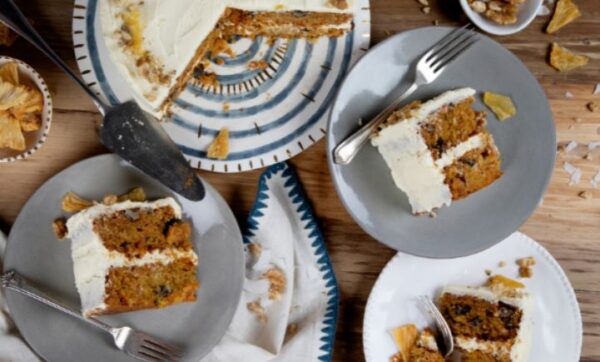Lifestyle
A guide to baking top-notch carrot cake

When it comes to cakes, carrot cake is probably the most iconic cake seen worldwide. It’s no wonder because a good carrot cake is simply the best and we can’t be convinced otherwise!
Whoever first decided to grate carrots into a cake, thank you, and whoever decided to pair said carrot cake with cream cheese icing, you’re a genius. Simply put, it is the most delicious pairing to exist. Plus, a good carrot cake is probably the single best use we’ve ever seen for carrots and we’re all for hidden veggies, especially when executed in the most delicious cakey ways.
Now having established that we’re BIG carrot cake fans, there is a lot to be said about a disappointing carrot cake… If you know, you know!
Which brings us to this guide, which was designed with only top-notch carrot cakes in mind:
1. Don’t skimp on the goods
Making an epic carrot cake is NOT going to be the most affordable cake you can make, but that is what makes a delicious carrot cake so sought-after.
To get the best results, you really do need to use high-quality ingredients. From the carrots to the spices to the eggs to the cream cheese, everything needs to be as fresh and as high quality as possible.
Also, while we’re on the topic of grand carrot cakes, more really is more! Carrot cakes should be jewelled with ALL THE GOODS. Whether this be nuts, either walnuts or pecans, pineapple, cranberries, desiccated coconut, raisins, crystallised ginger – you name it – the best carrot cakes are always loaded with lots of tasty morsels!
2. Grating your carrots
While this may seem like a bit of an arbitrary topic, the way you grate carrots is crucial to the successful execution of the cake! Not only do carrots add a wonderfully sweet, earthy flavour that pairs beautifully with a few signature warming spices, they also play a key role in carrot cake’s luscious texture.
Perfectly grated carrots provide a soft yet distinct texture, as well as ensuring the cake is wonderfully moist, and yes, we went there, moist is the best word to use in this case!
While you don’t necessarily have to peel them before grating, do make sure to give your carrots a good scrub and dry before getting started. The key to reaping optimal benefits from your carrots is to ensure they are evenly grated and the best way to achieve this is to go old-school and hand-grate them on the normal side of a box grater.
Using a food processor, while convenient, can often make them too fine or result in an inconsistent texture, which will undoubtedly affect the result.
3. Making and baking
Sadly, not much can be done about a bad recipe, because not all recipes are created equal, but when you find a good carrot cake recipe, hold onto it!
Stellar recipes will call for the ingredients to be at room temperature and include balanced ratios of flour, sugar, oil, and carrots to ensure moistness and flavour. They will also include a blend of warm spices like cinnamon, nutmeg, and cloves for depth of flavour. But most importantly, a good recipe will call for the mixing of wet and dry ingredients separately before combining and then gently fold in the carrots to avoid overmixing. This is crucial and indicates attention to texture and flavour.
In most carrot cake recipes, a combination of baking powder and bicarbonate of soda is often called for. Both play a crucial role in achieving the perfect texture, rise, and colour. Baking powder provides a reliable lift to the cake, while bicarbonate of soda reacts with acidic ingredients to enhance browning and contribute to a deeper, golden hue. Together, these leavening agents ensure a well-risen, tender cake with a rich, flavourful crumb!
Good recipes will also allow for personalisation to suit your taste preferences by making mention of add-ins like nuts, pineapple, raisins or other goodies. (Refer to step 1, paragraph 3 for more reference.)
Another note on baking cakes, if you can smell the cake baking in the oven, and it’s starting to make you feel hungry, that’s when it’s a good time to go in and test with a toothpick. If it comes out clean, then your cake is ready to come out the oven and cool before cutting or icing.
4. Cream cheese icing
If the recipe calls for some sort of lemon glaze or lemony buttercream, ditch it! Or at least do yourself a solid favour and swap it out for a cream cheese icing. All good carrot cakes come with a healthy serve of cream cheese icing – we don’t make the rules, but when cream cheese icing is involved, we’re happy to follow them!
For making the cream cheese icing, you ideally need to use thick cream cheese that comes in blocks. They have a firmer consistency, which produces more desirable results. Also, always ensure both your butter and cream cheese are at room temperature before attempting to make your icing.
And lastly, do not overmix your cream cheese icing; this will result in a split icing disaster! Often the best approach is to first cream the butter and icing sugar together until thick and smooth and then incorporate the cream cheese at the very last moment.






